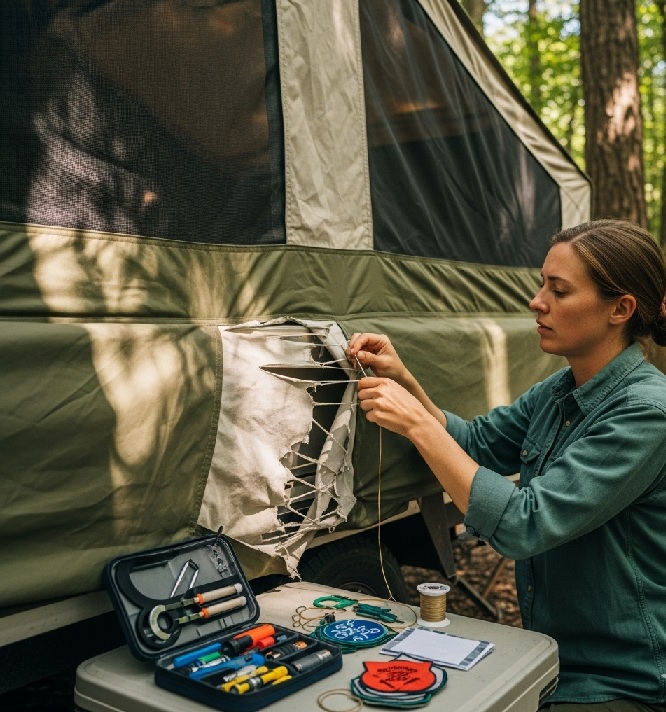This blog post may contain affiliate links. As an Amazon Associate I earn from qualifying purchases.
Imagine you’re out on a camping trip, surrounded by nature’s beauty. The stars are twinkling above, the fire is crackling, and everything seems perfect—until you notice a rip in your tent trailer canvas.
This small tear can quickly turn into a big problem if not addressed. But don’t worry, you’re not alone in facing this challenge. With the right guidance, you can repair the rip and ensure your adventures continue smoothly. You’ll discover straightforward methods to fix a rip in your tent trailer canvas.
We’ll guide you step-by-step, making sure you feel confident in tackling the repair yourself. By the end, you’ll not only have a sturdy canvas but also the satisfaction of solving the problem on your own. So, let’s dive in and make sure your camping gear is ready for your next adventure.
Assessing The Damage
Repairing a rip in your tent trailer canvas starts with assessing the damage. This step is crucial. It helps you decide the best repair method. Proper assessment prevents further damage. It also ensures a long-lasting fix. Let’s dive into the details.
Identifying Tear Type
First, identify the type of tear. Is it a clean cut or a jagged rip? Clean cuts are easier to repair. Jagged rips need more attention. Look closely at the edges. Are they frayed or smooth? Frayed edges indicate fabric weakness. Consider using a patch for better reinforcement. Understanding the tear type is key to a successful repair.
Measuring The Rip
Next, measure the rip accurately. Use a measuring tape for precision. Measure both length and width. This helps in choosing the right patch size. A patch that’s too small won’t hold. A too-large patch may be wasteful. Accurate measurements ensure a perfect fit. Write down the measurements for reference. This step simplifies the repair process.
Gathering Repair Materials
Gathering repair materials is essential for fixing a rip in tent trailer canvas. Collect a heavy-duty needle, strong thread, and a patch kit. Make sure the patch matches the canvas material.
Repairing a rip in your tent trailer canvas may seem daunting, but with the right materials, you can tackle the task effectively. Before you begin, it’s crucial to gather everything you need to ensure a smooth repair process. This step not only saves time but also prevents frustration when you’re in the middle of the repair. Imagine you’re out on a camping trip, and a sudden rip threatens your shelter. With the right materials on hand, you can fix it and continue enjoying the wilderness.
Essential Tools
The first item on your list should be a good pair of scissors. You’ll need these for cutting your patch material to size. Make sure they’re sharp enough to cut smoothly but safe to use. Next, grab a canvas repair kit. These kits often include special adhesives and patches designed for canvas materials. They provide a reliable seal that withstands outdoor conditions. A needle and thread can come in handy for small tears. Opt for thread that matches your canvas color for a seamless repair. Do you have a clean cloth? You’ll need it to wipe down the canvas around the tear, ensuring the patch sticks properly. A clean surface is vital for a strong bond.
Choosing The Right Patch
Selecting the right patch is crucial for a lasting repair. Consider the material of your canvas first. Is it made of cotton or synthetic fibers? Each requires different patch types. Opt for patches that are water-resistant. This ensures your repair holds up against rain or moisture, keeping your tent trailer dry inside. Size matters when choosing a patch. Ensure it’s large enough to cover the entire tear with a bit of overlap.
This prevents stress on the edges and prolongs the repair’s life. Would a self-adhesive patch suit your needs? They simplify the process by eliminating the need for glue. However, ensure it’s compatible with your canvas type. Gathering repair materials is about foresight and preparation. What unexpected mishaps have you managed with the right tools at hand?
Preparing The Canvas
Fixing a rip in tent trailer canvas ensures durability. Clean the area, then apply a patch with adhesive. Allow it to dry completely for a strong bond.
Preparing the canvas before repairing a rip in your tent trailer is a crucial step that ensures a successful and durable fix. A well-prepared canvas makes all the difference in the longevity of your repair. Have you ever patched something, only to see it fall apart soon after? This is why proper preparation is key. Let’s break down the essential steps to get your canvas ready for repair.
Also Read: How to Repair Tent Window: Quick DIY Fixes
Cleaning The Area
Before you start any repair, make sure the canvas is clean. Dirt and debris can prevent adhesives from sticking properly. Use a mild soap and warm water to gently clean the area around the rip. A soft brush can help scrub away any stubborn grime. Be thorough but gentle to avoid making the rip worse. Once the area is clean, rinse thoroughly with water to remove any soap residue. Leftover soap can interfere with adhesives and weaken the repair. Consider using a clean cloth to wipe away excess water and ensure no soap remains.
Drying The Canvas
Drying the canvas is just as important as cleaning it. Moisture can cause adhesives not to bond properly, leading to failed repairs. Allow the canvas to air dry completely. If you’re in a hurry, a hairdryer on a low setting can speed up the process. Just be careful not to overheat the material, as this could cause damage. Think of the drying process as a way to ensure your repair lasts. A dry canvas provides the perfect surface for adhesive or patches to cling to.
Once the canvas is dry, you’re ready to move on to the next step in your repair journey. By preparing your canvas properly, you’re setting the stage for a repair that will withstand the test of time and elements. Have you considered how much time a well-prepared repair could save you in the future? It might seem like extra work now, but it can save you from repeated repairs down the road.

Credit: www.amazon.com
Patching The Rip
Fixing a tear in tent trailer canvas is simple with basic tools and materials. Clean the area, apply strong adhesive, and press a patch firmly over the rip. Ensure the patch completely covers the tear for best results.
Repairing a rip in your tent trailer canvas may seem daunting, but with the right approach, it’s a straightforward task. Imagine the joy of camping without worrying about rain seeping through a tear. Patching the rip effectively is crucial to ensuring your adventures stay dry and comfortable. This guide will walk you through the process, offering practical tips and insights to make the repair as seamless as possible.
Applying The Patch
The first step in patching a rip is to choose the right patch material. Canvas patches or repair kits are readily available at outdoor stores. These kits often include everything you need for a quick fix. Before you apply the patch, make sure the area around the rip is clean and dry. Dirt or moisture can prevent the patch from sticking properly.
Use a mild soap and water solution to clean the canvas, and allow it to dry completely. Cut the patch so it’s at least an inch larger than the rip on all sides. This extra material will ensure a strong bond and prevent the tear from spreading. Align the patch with the rip, making sure it covers the area completely.
Securing With Adhesive
Once your patch is in position, it’s time to secure it with adhesive. A strong adhesive ensures the patch stays in place through all weather conditions. Apply a generous amount of adhesive to the patch’s edges.
Press down firmly on the patch, smoothing out any air bubbles. This ensures a tight bond between the patch and the canvas. Consider the type of adhesive you use. Some adhesives are specifically designed for outdoor fabrics and provide a waterproof seal. If you’re unsure, ask for recommendations at your local outdoor store.
Have you ever experienced the frustration of a patch peeling off mid-camping trip? This can often be avoided by allowing the adhesive to cure fully. Check the product instructions for curing times and avoid using the tent trailer until the adhesive has set completely. Repairing a rip in your tent trailer canvas not only extends its life but also saves you from costly replacements. Do you feel ready to tackle that rip and get back to enjoying the great outdoors?
Stitching The Canvas
Repairing a tent trailer canvas rip involves simple steps. Start by cleaning the area around the tear. Use a repair kit to patch the rip, ensuring a snug fit for durability.
Repairing a rip in your tent trailer canvas can feel daunting, but with a little patience and the right know-how, you can do it yourself. Stitching the canvas is a vital part of the process. It ensures that your tent remains durable and ready to withstand the elements again. You’ll need to focus on choosing the right materials and techniques to make your repair last.
Choosing The Thread
The thread you choose can make or break your repair. Opt for a heavy-duty polyester or nylon thread. These threads are known for their strength and resistance to UV rays and moisture. Avoid using cotton thread. It may seem like a good option, but it weakens quickly when exposed to the elements. You want your repair to last for many camping trips to come. Consider the color, too. A thread that matches your canvas will blend in seamlessly, giving your repair a professional finish.
Sewing Techniques
When sewing the canvas, your technique matters. Start by using a simple running stitch or backstitch. These stitches are strong and offer the flexibility needed for canvas material. Keep your stitches evenly spaced. This not only looks neater but ensures an even distribution of tension across the fabric. You might want to practice on a scrap piece of canvas before tackling the real repair. Don’t rush the process. Take your time to ensure each stitch is secure.
It might take a little longer, but the result is worth it. A well-stitched canvas can withstand wind, rain, and the occasional curious animal. Have you ever thought about the satisfaction of repairing something with your own hands? It’s not just about saving money; it’s about the pride and confidence that comes with doing it yourself. Plus, you’ll have a story to share around the campfire.
Sealing The Repair
Fixing a tent trailer canvas rip involves cleaning, patching, and sealing. Ensure the canvas is clean and dry. Apply a strong adhesive patch over the rip for a durable seal.
Sealing the repair is a crucial step in fixing a rip in tent trailer canvas. It ensures the patch stays secure and the tent remains waterproof. A well-sealed repair will keep you dry during rainy adventures. Here’s how to effectively seal your repair.
Waterproofing Methods
Choose a suitable waterproofing spray. Look for one designed for outdoor fabrics. Spray evenly over the repaired area. Let it dry fully before using the tent. This creates a protective barrier against rain and moisture. Some prefer seam sealers for added protection. Apply them along the edges of the patch. They provide extra assurance against leaks.
Testing For Leaks
Test the repair by spraying water on it. Use a spray bottle for controlled application. Check for any signs of leaks or dampness. If water seeps through, the seal needs reinforcement. Apply more seam sealer or waterproof spray. Test again to ensure the repair holds. A well-done repair keeps your tent dry and comfortable.
Maintaining Canvas Integrity

Fixing a rip in tent trailer canvas involves cleaning the area and applying a canvas repair kit. This ensures the canvas remains strong and protects against weather. Regular checks and timely repairs help maintain the tent’s durability.
Maintaining the integrity of your tent trailer canvas is crucial for ensuring your camping adventures remain dry and enjoyable. A small rip can quickly become a larger problem if not addressed promptly. Regular maintenance and inspections can help you catch issues early, saving you time and money in the long run. Let’s dive into practical steps you can take to keep your canvas in top condition.
Regular Inspections
Regular inspections are your first line of defense against canvas damage. Schedule a thorough check before and after each camping season. Look for small tears, holes, or areas where the canvas seems thin. Pay special attention to seams and corners, as these spots often face the most stress. During my last camping trip, I noticed a small tear near the door seam. Catching it early allowed me to patch it up before it worsened during a sudden rainstorm. This quick check took just a few minutes but saved me from a potentially wet and uncomfortable night.
Tips For Longevity
Extending the life of your tent trailer canvas involves a few simple steps. First, always store your canvas dry and clean. Moisture can lead to mold and mildew, which weakens the fabric. After a trip, make sure to let it air out thoroughly before packing it away. Consider using a protective spray to add a water-resistant layer. These sprays can be found at most camping stores and are simple to apply. A friend once told me how her family’s tent trailer canvas lasted over a decade, largely because they diligently applied a waterproofing spray each season.
Think about where you set up camp. Avoid areas under trees with falling branches or sap, which can damage your canvas. An easy choice of campsite can save you from unnecessary repairs. Have you thought about how a simple change in habit could extend your canvas’s lifespan? The small steps you take today in maintaining your tent trailer canvas can lead to years of worry-free camping. What actions will you take on your next trip to ensure your canvas stays strong?

Credit: www.southernglamper.com
Frequently Asked Questions
How Do You Fix A Tent Trailer Canvas Tear?
To repair a canvas tear, clean the area first. Use a strong adhesive or canvas repair tape. Press firmly to ensure adhesion. Allow it to dry completely before use. It’s crucial to use waterproof materials to prevent leaks. Regular maintenance can prevent future tears.
What Materials Are Needed For Canvas Repair?
You’ll need canvas repair tape or patch, adhesive, and scissors. Ensure the materials are waterproof for longevity. A cleaning solution is also necessary to prepare the surface. These materials are available at camping or outdoor stores. Always follow the manufacturer’s instructions for best results.
Can You Sew A Ripped Tent Canvas?
Yes, sewing is a viable option. Use a heavy-duty needle and UV-resistant thread. Reinforce the stitching with a waterproof sealant. Sewing provides a durable and lasting fix. Ensure the area is clean and dry before starting. Regularly check and maintain your repairs.
How Long Does A Canvas Repair Last?
A well-done repair can last for years. It depends on the quality of materials and repair technique. Regular maintenance extends the repair’s lifespan. Environmental factors like sun and rain can affect durability. Always inspect your canvas before trips to ensure reliability.
Conclusion
Repairing a rip in tent trailer canvas is simple. Follow the steps carefully for best results. Choose strong materials for patching. Ensure the canvas is clean and dry. Use a needle and thread to secure the patch. Apply a waterproof sealant to protect the repair.
Regular checks on your canvas prevent future rips. Maintain your tent trailer well for longer life. With these tips, your trailer stays in great shape. Enjoy your outdoor adventures with peace of mind. A little care goes a long way in preserving your gear.
Keep exploring and stay safe!


